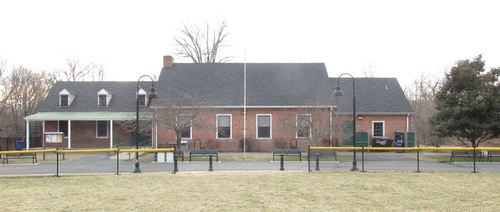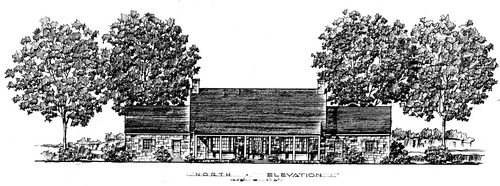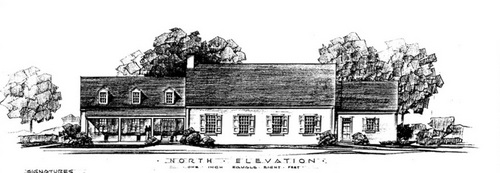Palisades’ humble rec center exemplifies great park planning
In the 1930s, architects carefully planned the Palisades Recreation Center to take advantage of its location overlooking the Potomac River. 80 years later, it’s still an informative model for park planning.
Designers carefully planned the rec center, at 5200 Sherrier Place NW, to be more than just a collection of ball fields and playgrounds. They oriented buildings to take advantage of natural vistas, located baseball diamonds so their outfields double as public greens, and used unpretentious but beautiful architecture to balance the need for man-made structures with the surrounding natural beauty.
The result is a 13-acre green space that’s as much a small national park as it is community playground.
Unlike other DC playgrounds established in the 1920s and 1930s, the Palisades rec center was designed by the National Park Service (NPS) as part of the Public Works Administration. The rec center opened to the public on September 11th, 1936. As of a 2014 study, the field house is eligible for inclusion on the National Register of Historic Places.
But changes began to come in 2008 with DC’s first artificial turf soccer field, and continued in 2013 with a new playground. Now, the Department of Parks and Recreation (DPR) and the Department of General Services are developing a plan to address the aging field house, as part of DPR’s Play DC initiative.
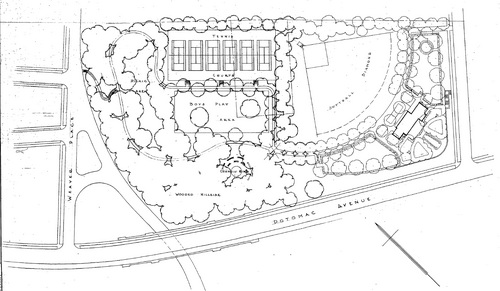
A site plan for the Palisades rec center from late in 1935. Though this isn’t the final plan, the building, the overlook, and the baseball field are all present. All images from the National Parks Service except where noted.
How it all happened
Thomas Chalmers Vint, an architect and landscape architect, supervised design and construction of the project between 1934 and 1936. Vint advocated the idea of having master plans for parks, to look at them comprehensively from planning through to construction. At many parks or monuments today, Vint’s influence can still be seen in fine rustic buildings, bridges, and in how developed areas blend with the environment.
The NPS made park development plans mandatory in 1929. Under Vint’s leadership, five-year plans became the standard for streamlining landscape preservation and park development.
At Palisades, Vint played an active role in the field house’s design and setting. Plans for the site prior to Vint’s involvement, from 1931, show a grouping of small buildings at the northern end of the property. That plan failed to materialize, and so community members pushed for a field house in early 1934. That coincided with Vint’s move to Washington to become Chief Architect of NPS’ Branch of Plans in Designs.
Planning for the new recreation center got underway in February 1935. Plans for both the playground and the building evolved, as designers tried to find a scheme that worked. They went through four different building proposals until settling on the eventual design, each plan being more informal and in harmony with nature than the one before.
The final design, dated October 1, 1935, is an asymmetrical three-part red-brick structure. The result is a building that looks informal and vernacular.
The grounds
Based on the building’s asymmetry, its placement toward the southern end of the playground, and its orientation facing north-south, we know that every effort went into ensuring the field house did not overpower the natural beauty of the site. Instead, the building enhanced and was subservient to that beauty.
The building, along with its southern facing terrace, functions as a scenic overlook to the Potomac River. Palisades is the only Washington playground to have such a feature. This was, again, a result of Vint’s oversight and experience.
While the overlook is the most notable feature of the site, others include a baseball diamond, tennis courts, a nature trail, and an outdoor picnic area. All are in places where they’re unobtrusive and subordinate to nature. For example, the baseball infield and tennis courts are along the trolley right of way on the northeast border of the property, leaving less intense uses for the property interior.
It is particularly noteworthy that the baseball diamond’s home plate is at the north end of the field, both giving residents fast access to home plate, and allowing the outfield to double as a meadow when people aren’t playing baseball. We know that was intentional based on plans from 1935.
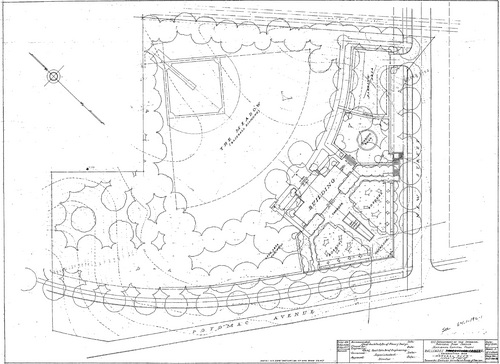
A partial site plan, dated July 17, 1935. It notes the meadow (which is the baseball field) and overlook.
Continue the legacy
The 1930s may be a long time ago, but we need good parks as much today as we did then. As DPR renovates Washington’s aging parks, it will be important for today’s generation of planners to think of these places in comprehensive terms, and not as only locations for active sports fields.
Washington needs strong long-term planning if it’s going to manage its public resources efficiently and equitably. DPR’s Play DC master plan is a good overall approach in concept. But it’s still prone to piecemeal planning since DPR and DGS only plan for projects that have dedicated funding. This ad hoc approach makes it hard to create master plans, and hard to prioritize long term visions.
The Palisades Recreation Center’s mid-1930s design is an example of how master planning can and should apply to Washington’s recreation areas.

